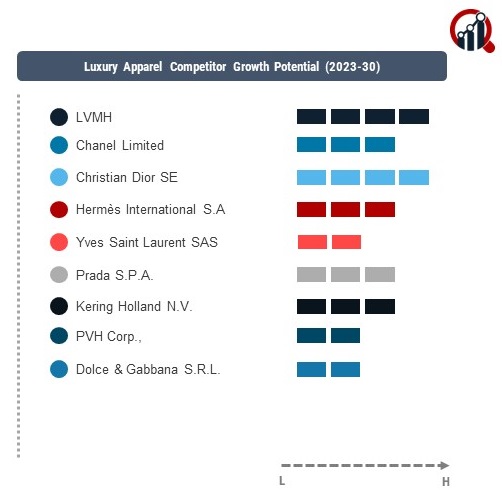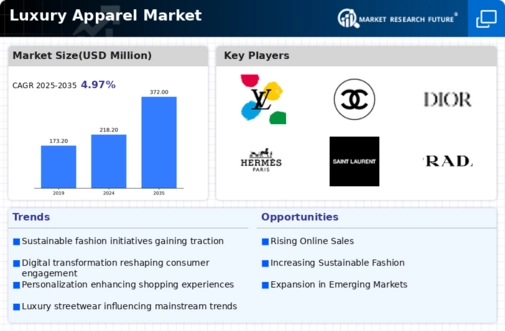Top Industry Leaders in the Luxury Apparel Market
 The competitive landscape of the luxury apparel market is characterized by key players implementing diverse strategies to navigate the complex world of high-end fashion. As of 2023, major players have entrenched their positions, focusing on brand differentiation, exclusivity, and digital presence to cater to the discerning tastes of luxury consumers.
The competitive landscape of the luxury apparel market is characterized by key players implementing diverse strategies to navigate the complex world of high-end fashion. As of 2023, major players have entrenched their positions, focusing on brand differentiation, exclusivity, and digital presence to cater to the discerning tastes of luxury consumers.
Key Players:
LVMH
Chanel Limited
Christian Dior SE
Hermès International S.A
Yves Saint Laurent SAS
Prada S.p.A.
Ralph Lauren
Kering Holland N.V.
PVH Corp.
Dolce & Gabbana S.r.l.
Market Share Analysis:
Strategies adopted by these key players revolve around exclusivity, digital transformation, and sustainability. LVMH and Kering, in particular, emphasize the exclusivity of their brands through limited editions, collaborations with renowned designers, and meticulous craftsmanship. Richemont places a strong emphasis on heritage and craftsmanship, positioning its luxury brands as timeless and investment-worthy. The Estée Lauder Companies leverage their expertise in beauty to create luxury experiences with personalized and high-end skincare and fragrance offerings. Prada focuses on digital innovation, engaging with consumers through online platforms, social media, and virtual experiences to enhance brand visibility and accessibility.
News & Emerging Companies:
The luxury apparel market have gained attention in 2023, introducing new perspectives and approaches to luxury fashion. Emerging designers and boutique luxury brands, often with a focus on sustainability, customization, and unique design aesthetics, contribute to the diversification of the market. While their market share may be relatively modest compared to industry giants, their emphasis on niche markets and ethical practices resonates with a segment of consumers seeking alternatives to traditional luxury offerings.
Industry Trends:
Industry trends highlight the growing importance of e-commerce, sustainability, and digital innovation within the luxury apparel market. Luxury brands are investing heavily in online platforms, enhancing their digital presence, and embracing e-commerce to reach a global audience. Additionally, there is an industry-wide shift toward sustainability, with luxury brands incorporating eco-friendly practices in manufacturing and retail operations. This includes the use of sustainable materials, ethical sourcing, and initiatives to reduce environmental impact.
Competitive Scenario:
The luxury apparel market reflects a blend of established players and emerging disruptors, all navigating a landscape shaped by shifting consumer preferences, digital transformation, and sustainability considerations. Key players maintain their dominance through iconic brand legacies, high-end craftsmanship, and strategic investments in both physical and digital retail experiences. Emerging companies contribute to the market's dynamism with a focus on niche markets, sustainability, and innovative business models. The competition is further intensified by the entry of emerging designers, the rise of sustainable luxury, and the integration of cutting-edge technologies in the luxury shopping experience.
Recent Development
The accelerated adoption of virtual try-on technologies by major luxury brands. Some key players have implemented augmented reality (AR) and virtual reality (VR) solutions, allowing consumers to virtually try on luxury apparel and accessories before making online purchases. This development aligns with the industry's efforts to enhance the online shopping experience and address challenges associated with purchasing high-end fashion items without physically trying them on.










